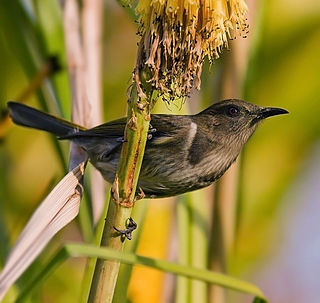
The honeyeaters are a large and diverse family, Meliphagidae, of small to medium-sized birds. The family includes the Australian chats, myzomelas, friarbirds, wattlebirds, miners and melidectes. They are most common in Australia and New Guinea, and found also in New Zealand, the Pacific islands as far east as Samoa and Tonga, and the islands to the north and west of New Guinea known as Wallacea. Bali, on the other side of the Wallace Line, has a single species.

The Foja Mountains are located just north of the Mamberamo river basin in Papua, Indonesia. The mountains rise to 2,193 metres (7,195 ft), and have 3,000 square kilometers of old growth tropical rainforest in the interior part of the range. The Foja forest tract covers 9,712 square kilometers and is the largest tropical forest without roads in the Asia Pacific region.
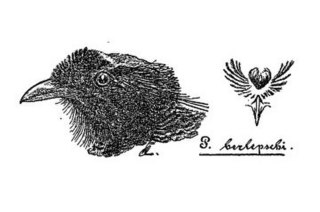
The bronze parotia, also known as the Foja parotia, Berlepsch's parotia or Berlepsch's six-wired bird-of-paradise, is a species of bird-of-paradise, in the family Paradisaeidae. It resembles and is often considered to be a subspecies of Carola's parotia, but a high majority of authorities support its specific status.
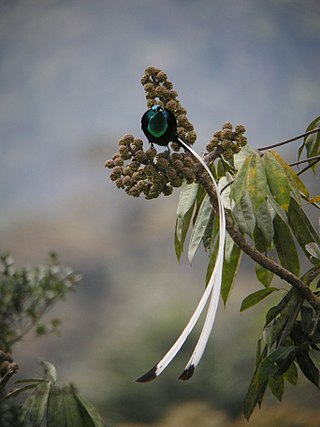
Astrapia is a genus of birds-of-paradise. The genus contains five species, all endemic to New Guinea. The males have highly iridescent plumage and remarkably long tails. Females are duller and have shorter tails.

Epimachus is a genus of birds-of-paradise (Paradisaeidae) that includes two species, found in the highland forests of New Guinea. They are the largest members of the family. The common name "sicklebill" refers to their long, decurved, sickle-shaped bill.

Diphyllodes is a genus of birds-of-paradise. Established by René-Primevère Lesson in 1834, it contains two species: the magnificent bird-of-paradise and Wilson's bird-of-paradise. Both species are endemic to New Guinea, where they are found in forested uplands. The genus is sometimes subsumed into the genus Cicinnurus.

The magnificent bird-of-paradise is a species of bird-of-paradise. The magnificent bird-of-paradise is evaluated as Least Concern on the IUCN Red List of Threatened Species. They are listed in Appendix II of CITES.
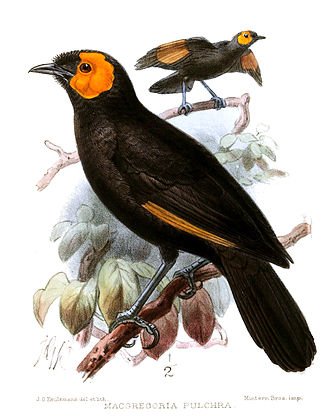
MacGregor's honeyeater, also known as giant wattled honeyeater, MacGregor's giant honeyeater, MacGregor's bird of paradise, and ochre-winged honeyeater, is a large black crow-like bird with large orange-yellow eye-wattles and black-tipped, ochre primary wing feathers. The sexes are similar, with the male being slightly larger than the female. It is the only member of the genus Macgregoria.

The wattled smoky honeyeater or Foja honeyeater is a species of honeyeater with a sooty-grey plumage and a black bill. The most distinctive feature is arguably the extensive reddish-orange facial skin and pendulous wattle. In other members of the genus Melipotes, these sections only appear reddish when "flushed" and the wattle is smaller.
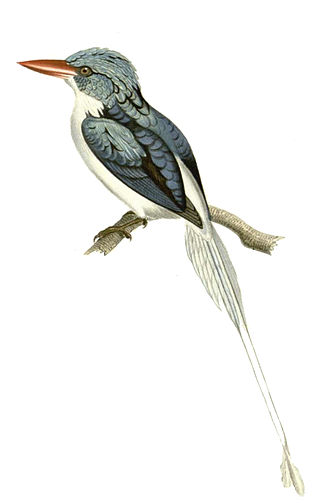
The Biak paradise kingfisher is a tree kingfisher that is endemic to the Indonesian island of Biak which is one of a small group of islands located in Cenderawasih Bay near the northern coast of Papua. This bird has a turquoise-blue back with a white belly and tail streamers and a reddish beak. Its natural habitat is forests and the IUCN has assessed its conservation status as being "near-threatened".
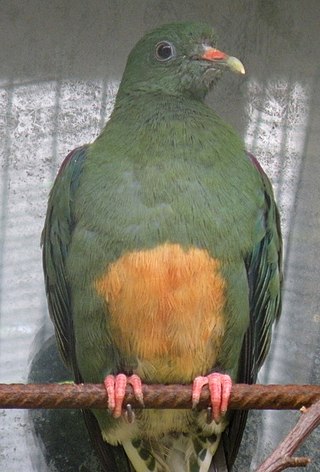
The orange-bellied fruit dove is a small pigeon with mainly green plumage, distinguished by a large orange patch on the lower breast and belly, a small lilac shoulder patch, pale yellow undertail coverts, and a grey terminal band on the tail.
The Papuan spinetail, also known as the Papuan needletail, New Guinea spine-tailed swift or Papuan spine-tailed swift, is a small, stocky swift with a short, rounded tail and very fast flight. Head and upperparts glossy blue-black, white or whitish belly and undertail coverts, dark underwing with pale central stripe. The small spines at the end of the tail are not visible in flight.

The streak-headed mannikin also known as the streak-headed munia, is a small 10 cm (3.9 in) long estrildid finch.

The singing starling is a medium-sized starling.

The uniform swiftlet, also known as the Vanikoro swiftlet or lowland swiftlet, is a gregarious, medium-sized swiftlet with a shallowly forked tail. The colouring is dark grey-brown, darker on the upperparts with somewhat paler underparts, especially on chin and throat. This species is widespread from the Philippines through Wallacea, New Guinea and Melanesia. It forages for flying insects primarily in lowland forests and open areas. It nests in caves where it uses its sense of echolocation, rare in birds, to navigate.
The Wau Ecology Institute (WEI) was established in 1961 near the town of Wau, Papua New Guinea, in Morobe province, as a field station of the Bishop Museum. In 1973 it became an independent environmental organisation. It has laboratory space for visiting scientists, a herbarium and zoological reference collections. The Institute ceased operations around 2007 and is now run as a local coffee plantation by former employees and area gold miners.

The black-mantled goshawk is a species of bird of prey in the family Accipitridae. It is found in the highlands of New Guinea. Its natural habitat is subtropical or tropical moist lowland forests. This species was formerly placed in the genus Accipiter.

Ailuroedus is a genus of birds in the bowerbird family, Ptilonorhynchidae, native to forests in Australia and New Guinea. The common name, catbird, refers to these species' "wailing cat-like calls". The scientific name Ailuroedus is derived from the Greek 'ailouros', meaning cat, and 'eidos', referring to form.
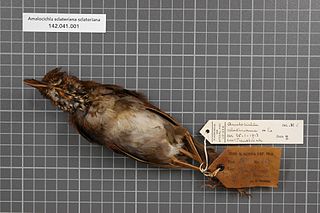
The greater ground robin is a species of bird in the family Petroicidae. It is found in New Guinea.
Schodde's bird of paradise is a bird in the family Paradisaeidae that is an intergeneric hybrid between a Lawes's parotia and blue bird-of-paradise.

















